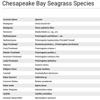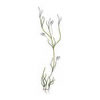
Use our interactive table to sort and search seagrasses by common name, species name, or family.

The most abundant species of submerged aquatic vegetation in Chesapeake Bay are eelgrass (Zostera marina), widgeongrass (Ruppia maritima), wild celery (Vallisneria americana), hydrilla (Hydrilla verticillata), redhead grass (Potamogeton perfoliatus), sago pondweed (Stuckenia pectinata), and Eurasian watermilfoil (Myriophyllum spicatum). Z. marina and R. maritima are also the dominant species found in the coastal bays of the Delmarva Peninsula. Learn more about these species below.

Use our interactive table to sort and search seagrasses by common name, species name, or family.
Zostera marina is the only true seagrass in Chesapeake Bay. It typically dominates in the Bay's higher salinity regions.

Ruppia maritima, a "boom-and-bust" species, dominates the shallow waters of the middle Bay.

Vallisneria americana is a freshwater species and an important habitat and food source for a host of aquatic organisms.

Hydrilla verticillata was introduced into the U.S. in the 1960s. It is now observed throughout upper Chesapeake Bay.

Potamogton perfoliatus is found in both fresh and brackish waters of Chesapeake Bay.

Sago pectinatus is eaten by waterfowl and provides habitat for fish and invertebrates.

Myriophyllum spicatum was introduced to the U.S. in the late 1800s and has been a dominant species in Chesapeake Bay since the 1950s.